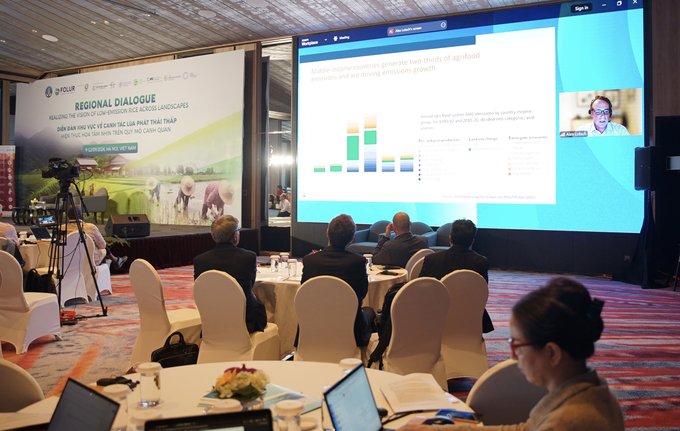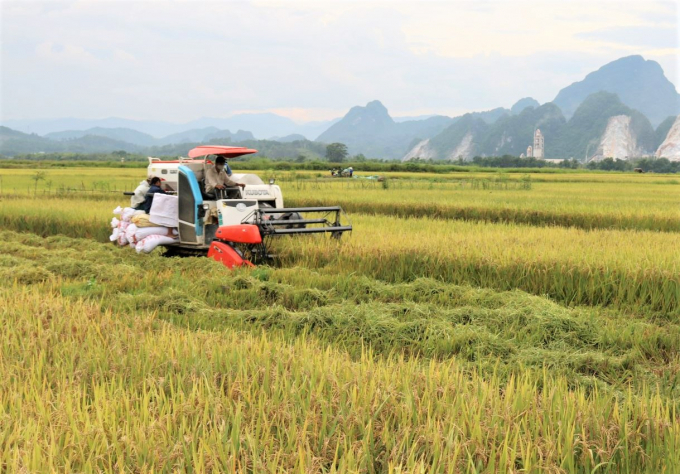December 2, 2025 | 11:29 GMT +7
December 2, 2025 | 11:29 GMT +7
Hotline: 0913.378.918
December 2, 2025 | 11:29 GMT +7
Hotline: 0913.378.918
In the second day of the Regional Dialogue of MARD and The Food Systems, Land Use, and Restoration (FOLUR)Impact Program 'Realizing the vision of low-emission rice across landscapes' on September 10, Work Bank expert - Mr. Alexander Lotsch shared on the transitioning to a liveable planet - incentives, policies, expenditures for low emission rice.
The global agri-food system is caught in a vicious cycle of increasing emissions and food production demands, driven by a growing global population. According to the World Bank's flagship report, "Recipe for a Livable Planet: Achieving Net Zero Emissions in the Agrifood Syste” this sector is responsible for about 16 gigatons of CO2 emissions annually—roughly one-third of global greenhouse gas emissions. The report presents the world’s first comprehensive strategic framework to decarbonize the agri-food system, stressing that breaking this cycle is critical to meeting climate goals, including the Paris Agreement’s target to limit global warming to 1.5°C.
As the demand for food has surged, so have emissions. Global heating caused by these emissions depresses agricultural yields, prompting more intensive farming, which, in turn, leads to even higher emissions. This self-reinforcing loop traps the global agri-food system in an unsustainable cycle, threatening not only food security but also the planet’s climate stability.

Mr. Alexander Lotsch (World Bank) speaking online at Regional Dialogue of MARD and FOLUR Impact Program 'Realizing the vision of low-emission rice across landscapes' on September 10. Photo: Linh Linh.
Key sources of emissions in the agri-food system include pre- and post-production activities like fertilizer production, food waste, transport, and refrigeration. Interestingly, farming activities at the farm gate account for less than half of the total emissions. The largest share comes from land-use changes, including deforestation, often driven by agricultural expansion.
The report highlights that without substantial mitigation efforts within the agri-food system, the global climate goals set by the Paris Agreement cannot be achieved. Current projections show that if the world continues on its current trajectory, we will miss the target of limiting global warming to 2°C or below. However, by taking ambitious actions—especially in reducing agri-food emissions—the world has a strong chance of staying within the 1.5°C threshold.
Methane emissions from rice cultivation in Asia, for instance, play a significant role in global greenhouse gas emissions. Addressing these sector-specific emissions is essential to the broader decarbonization effort.
It categorizes emissions by income groups and reveals that middle-income countries are the primary drivers of agri-food emissions, responsible for nearly two-thirds of the total. However, they also hold three-quarters of the global cost-effective mitigation opportunities. These countries, with rapidly expanding agricultural sectors, have significant potential to reduce emissions cost-effectively, while simultaneously improving food security.
One of the report’s central findings is that there are no inherent trade-offs between climate action and food production. By implementing mitigation strategies such as carbon sequestration, boosting productivity, and increasing resilience to climate shocks, the agricultural sector can continue to meet global food demands while dramatically reducing its emissions.

Many cost-effective solutions are already available, such as renewable energy in fertilizer production, cleaner food transport, and innovations in farming practices.
Despite the agri-food system’s contribution to emissions, it receives only a tiny fraction of global climate finance. Currently, only 2% of mitigation finance goes to the agri-food sector, far below what is necessary to achieve global climate targets. The report calls for an 18-fold increase in climate finance for this sector, up to USD 260 billion annually, to halve agri-food emissions by the end of the decade.
Fortunately, many cost-effective solutions are already available, such as renewable energy in fertilizer production, cleaner food transport, and innovations in farming practices. By repurposing just USD 70 billion of existing public spending, we could cover up to 30% of the global costs needed to shift the agri-food system towards a sustainable, low-emission future.
The World Bank’s report offers a clear message: every country, regardless of income level, can and must contribute to the decarbonization of the agri-food system. High-income countries can lead by investing in renewable energy, shifting subsidies to low-emission food production, and providing financial and technical support to lower-income countries.
Middle-income countries, with their vast mitigation potential, must focus on reducing deforestation, managing rice production emissions, and improving soil health. Low-income countries, though contributing minimally to current emissions, can leapfrog to sustainable agricultural practices, preserving ecosystems and adopting climate-smart policies without following the high-emission pathways of wealthier nations.
By 2050, the world can significantly reduce, if not eliminate, agri-food emissions through collaborative efforts across all countries. The solutions exist, the technology is available, and the economic benefits are within reach. The agri-food system holds the key to a more sustainable, climate-resilient future. By breaking the vicious cycle of rising food production and emissions, we can not only protect our climate but also secure food for future generations.
To achieve net zero emissions in the agri-food system, partnerships with research organizations and technical bodies are essential. Collaboration is needed to pool resources, share knowledge, and implement innovative solutions effectively. However, the critical challenge remains in securing investment and ensuring smallholder farming families, who represent a significant portion of the agricultural workforce, have access to funds. This is a bottleneck in the system, as many smallholders lack the financial means to adopt sustainable practices without external support.
Organizations such as the World Bank and the Food and Agriculture Organization (FAO) play a vital role in bridging this gap. The assistance in policy reform and providing financial mechanisms can help create a sustainable financial model. Public funds alone are insufficient to address the scale of the challenge. Therefore, working closely with governments and the private sector becomes necessary to attract more substantial investment in climate-resilient agriculture.
Moreover, establishing robust monitoring systems, comprehensive databases, and integrating climate information will allow for better risk assessment. For example, setting up agricultural insurance schemes, tailored to protect farmers from climate-related losses, would be a significant step in securing long-term sustainability. Global expertise and collaboration in these areas can further strengthen the capacity to manage risks.
“As we look into decarbonizing the agri-food system, the largest sources of emissions come from land use, such as deforestation and methane emissions, particularly from rice cultivation and livestock. These sectors are especially difficult to decarbonize because of the technological and economic constraints involved. However, solutions like more efficient farming practices, carbon markets, and innovations in fertilizer production powered by renewable energy are being piloted in regions like the Mekong Delta in Vietnam. These efforts show promise in reducing emissions, particularly when combined with smarter irrigation and water management practices”,
Looking forward, innovations in both technology and financing—such as export payments for verified emission reductions—can help tackle hard-to-abate sectors, like livestock emissions and methane reduction. By continuing to invest in research and development, bringing down the cost of climate-smart technologies, and encouraging farmers through proper incentives, the path toward achieving net zero in agriculture becomes clearer.
While emissions in the agri-food system is complex, especially in sectors like livestock and methane, innovative solutions are available and are being explored globally. With coordinated efforts, strategic investments, and strong partnerships, the goal of a sustainable, low-emission agricultural future is within reach.

(VAN) The Institute of Agricultural Sciences for Southern Vietnam (IAS) marked its 100th anniversary in Ho Chi Minh City, celebrating a century of growth as a leading institute contributing significantly to Viet Nam’s agricultural development.

(VAN) An increasing number of livestock farms are using biogas generators to create a source of renewable electricity, helping to save costs and mitigate environmental pollution.

(VAN) Small changes in rice cultivation, from irrigation methods and straw collection to input management, are paving a new way for Vietnam's agriculture in the journey toward emission reduction.

(VAN) With the project of converting biogas into renewable electricity, Australia is both helping pig farms reduce their energy costs by up to 25% and contributing to environmental protection.
![Hue aims for Net Zero: [1] Initial steps from green transportation](https://t.ex-cdn.com/nongnghiepmoitruong.vn/608w/files/huytd/2025/11/28/0853-anh-6-giao-thong-xanh-hue-094717_940-153724.jpg)
(VAN) For sustainable development, Hue City is implementing many solutions to promote green transportation, which is an important initial step on the journey to building a Net Zero Hue.

(VAN) Nghe An Province, one of the localities with the largest forest area in Vietnam, is set to gain significant benefits from the implementation of forest carbon credit payments.

(VAN) Circular agriculture helps Mekong Delta farmers cut greenhouse gas emissions while boosting incomes through efficient reuse of agricultural by-products.